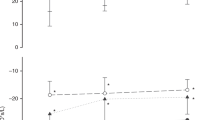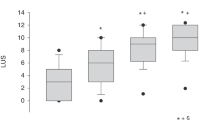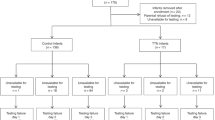Abstract
Background
The aim of this study was to describe the trajectory of oscillatory mechanics from the first week of life to term equivalent and evaluate whether oscillatory mechanics are associated with simultaneous lung disease in infants ≤32 weeks gestation.
Methods
In this observational, longitudinal study, we enrolled 66 infants. Forced oscillations were applied using a neonatal mechanical ventilator (Fabian HFOi) that superimposed oscillations (10 Hz, amplitude 2.5 cmH2O) on a positive end-expiratory pressure (PEEP). Measurements were performed at 5-7-9 cmH2O of PEEP or the clinical pressure ±2 cmH2O; they were repeated at 7, 14, 28 post-natal days, and 36 and 40 weeks post-menstrual age (PMA).
Results
The mean (range) gestational age of study participants was 29.2 (22.9–31.9) weeks. Nineteen infants (29%) developed bronchopulmonary dysplasia (BPD). Respiratory system reactance was significantly lower (lower compliance), and respiratory system resistance was significantly higher in infants with developing BPD from 7 post-natal days to 36 weeks PMA. All oscillatory mechanics parameters were significantly associated with the simultaneous respiratory severity score (p < 0.001 for all).
Conclusions
Serial measurements of oscillatory mechanics allow differentiating lung function trajectory in infants with and without evolving BPD. Oscillatory mechanics significantly correlate with the severity of simultaneous lung disease.
Impact
-
The results of the present study suggest that respiratory system reactance, as assessed by respiratory oscillometry, allows the longitudinal monitoring of the progression of lung disease in very premature infants.
-
This paper describes for the first time the trajectory of oscillatory mechanics in very preterm infants with and without evolving bronchopulmonary dysplasia from the first week of life to term equivalent.
-
Serial respiratory oscillometry measurements allow the identification of early markers of evolving bronchopulmonary dysplasia and may help personalizing the respiratory management strategy.
This is a preview of subscription content, access via your institution
Access options
Subscribe to this journal
Receive 14 print issues and online access
$259.00 per year
only $18.50 per issue
Buy this article
- Purchase on Springer Link
- Instant access to full article PDF
Prices may be subject to local taxes which are calculated during checkout



Similar content being viewed by others
Data availability
All data generated or analysed during this study are included in this article. Further enquiries can be directed to the corresponding author.
References
Doyle, L. W. et al. Bronchopulmonary dysplasia in very low birth weight subjects and lung function in late adolescence. Pediatrics 118, 108–113 (2006).
Collaco, J. M. & McGrath-Morrow, S. A. Respiratory phenotypes for preterm infants, children, and adults: bronchopulmonary dysplasia and more. Ann. Am. Thorac. Soc. 15, 530–538 (2018).
Gray, D. M. et al. Intra-breath measures of respiratory mechanics in healthy African infants detect risk of respiratory illness in early life. Eur. Respir. J. 53, 1800998 (2019).
Gray, D. et al. Determinants of early-life lung function in African infants. Thorax 72, 445–450 (2017).
Radics, B. L. et al. Respiratory oscillometry in newborn infants: conventional and intra-breath approaches. Front. Pediatr. 10, 867883 (2022).
Hantos, Z. et al. Assessment of respiratory mechanics with forced oscillations in healthy newborns. Pediatr. Pulmonol. 50, 344–352 (2015).
Gray, D. et al. Lung function and exhaled nitric oxide in healthy unsedated African infants. Respirology 20, 1108–1114 (2015).
Travers, C. P. et al. Non-invasive oscillometry to measure pulmonary mechanics in preterm infants. Am. J. Respir. Crit. Care Med. 204, 485–488 (2021).
Klinger, A. P. et al. Non-invasive forced oscillometry to quantify respiratory mechanics in term neonates. Pediatr. Res. 88, 293–299 (2020).
Dellacà, R. L. et al. Relationship between respiratory impedance and positive end-expiratory pressure in mechanically ventilated neonates. Intensive Care Med. 39, 511–519 (2013).
Zannin, E. et al. Oscillatory mechanics at 36 weeks post-menstrual age as markers of lung disease in preterm infants: a cohort study. Eur. Respir. J. 59, 2103023 (2022).
Veneroni, C., Wallström, L., Sindelar, R. & Dellacaʼ, R. L. Oscillatory respiratory mechanics on the first day of life improves prediction of respiratory outcomes in extremely preterm newborns. Pediatr. Res. 85, 312–317 (2018).
Bates, J. H., Schmalisch, G., Filbrun, D. & Stocks, J. Tidal breath analysis for infant pulmonary function testing. ERS/ATS Task Force on Standards for Infant Respiratory Function Testing. European Respiratory Society/American Thoracic Society. Eur. Respir. J. 16, 1180–1192 (2000).
Peterson-Carmichael, S. et al. An official American Thoracic Society/European Respiratory Society Workshop Report: evaluation of respiratory mechanics and function in the pediatric and neonatal intensive care units. Ann. Am. Thorac. Soc. 13, S1–S11 (2016).
Zannin, E., Neumann, R. P., Dellacà, R. & Schulzke, S. M. Forced oscillation measurements in the first week of life and pulmonary outcome in very preterm infants on noninvasive respiratory support. Pediatr. Res. 86, 382–388 (2019).
Dorkin, H. L. et al. Respiratory system impedance from 4 to 40 Hz in paralyzed intubated infants with respiratory disease. J. Clin. Investig. 72, 903–910 (1983).
Zannin, E. et al. Oscillatory mechanics in very preterm infants on continuous positive airway pressure support: reference values. Pediatr. Pulmonol. 58, 746–752 (2023).
Jensen, E. A. et al. The diagnosis of bronchopulmonary dysplasia in very preterm infants an evidence-based approach. Am. J. Respir. Crit. Care Med. 200, 751–759 (2019).
Veneroni, C., Wallström, L., Sindelar, R. & Dellacaʼ, R. L. Oscillatory respiratory mechanics on the first day of life improves prediction of respiratory outcomes in extremely preterm newborns. Pediatr. Res. 85, 312–317 (2019).
Loi, B. et al. Lung ultrasound to monitor extremely preterm infants and predict bronchopulmonary dysplasia a multicenter longitudinal cohort study. Am. J. Respir. Crit. Care Med. 203, 1398–1409 (2021).
Colin, A. A., McEvoy, C. & Castile, R. G. Respiratory morbidity and lung function in preterm infants of 32 to 36 weeks’ gestational age. Pediatrics 126, 115 (2010).
Henschen, M., Stocks, J., Brookes, I. & Frey, U. New aspects of airway mechanics in pre-term infants. Eur. Respir. J. 27, 913–920 (2006).
Hall, G. L., Hantos, Z., Sly, P. D. & Wildhaber, J. H. Contribution of nasal pathways to low frequency respiratory impedance in infants. Thorax 57, 396 (2002).
Loi, B. et al. Respiratory and haemodynamic effects of 6h-pronation in neonates recovering from respiratory distress syndrome, or affected by acute respiratory distress syndrome or evolving bronchopulmonary dysplasia: a prospective, physiological, crossover, controlled. eClinicalMedicine 55, 101791 (2023).
Vendettuoli, V. et al. Positional effects on lung mechanics of ventilated preterm infants with acute and chronic lung disease. Pediatr. Pulmonol. 50, 798–804 (2015).
Acknowledgements
We acknowledge Abedulrhman S Abdelfattah for their support in performing the measurements.
Author information
Authors and Affiliations
Contributions
E.Z. has contributed to the study design, data acquisition and data analysis and drafted the first version of the manuscript. C.R. contributed to the study design, data acquisition and clinical interpretation of results and approved the final manuscript as submitted. G.D. contributed to the data collection and critically revised the manuscript. R.D. supervised data acquisition and analysis and critically revised the manuscript. M.L.V. contributed to the study design and the clinical interpretation of the results and approved the final version of the manuscript.
Corresponding author
Ethics declarations
Competing interests
R.D. reports that Politecnico di Milano received research grants from Vyaire and licensed a patent for using FOT to assess lung volume recruitment to Vyaire. C.R. has received honoraria for lectures from Vyaire. The other authors have nothing to disclose. None of the authors received any form of payment to produce the manuscript.
Ethics approval and consent to participate
The local ethics committee (nr. 3804/21) approved the study and written informed consent was obtained from parents before enrollment.
Additional information
Publisher’s note Springer Nature remains neutral with regard to jurisdictional claims in published maps and institutional affiliations.
Supplementary information
Rights and permissions
Springer Nature or its licensor (e.g. a society or other partner) holds exclusive rights to this article under a publishing agreement with the author(s) or other rightsholder(s); author self-archiving of the accepted manuscript version of this article is solely governed by the terms of such publishing agreement and applicable law.
About this article
Cite this article
Rigotti, C., Zannin, E., Dognini, G. et al. Oscillatory mechanics trajectory in very preterm infants: a cohort study. Pediatr Res 94, 1998–2004 (2023). https://doi.org/10.1038/s41390-023-02724-w
Received:
Revised:
Accepted:
Published:
Issue Date:
DOI: https://doi.org/10.1038/s41390-023-02724-w



